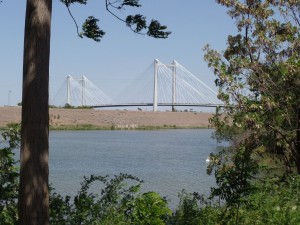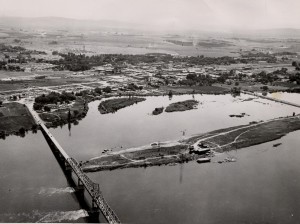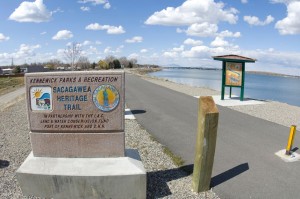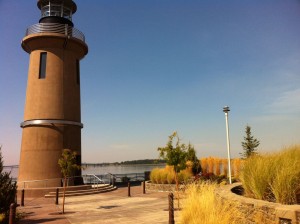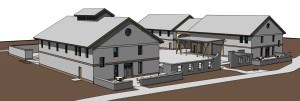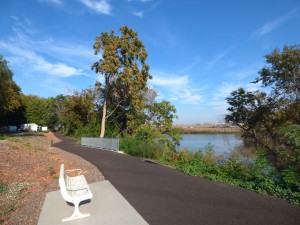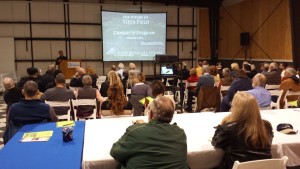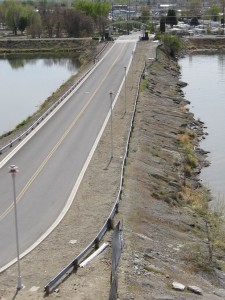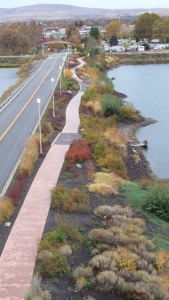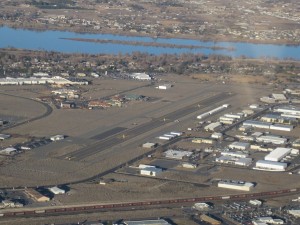In March of 2015, the Port of Kennewick (in Kennewick, Washington), celebrated its 100th anniversary as a port district. The Port of Kennewick is the fifth-oldest of the 76 ports in Washington State.
It was the very first port established in eastern Washington–organized just a few years after the Washington State Legislature approved a bill in 1911 authorizing the formation of port districts for economic development.
Since 1915, the port’s mission and services have evolved as the local economy has grown.
What started out as a small port district providing docking and terminal facilities for steamboats has grown to a 485-square-mile district serving the cities of Kennewick and West Richland, and portions of the city of Richland, Benton City, and Benton County.
Today the port’s mission is to facilitate trade and economic development and promote tourism.
The Port of Kennewick is leading efforts to reclaim and revitalize Kennewick’s historic downtown/waterfront neighborhoods; and redeveloping a 103-acre former general-aviation airfield into a “regional town center” to benefit the entire area.
Reclaiming the Riverfront
When the U.S. Army Corps of Engineers completed McNary Dam in 1954, a flood-weary community celebrated. The dam provided a new source of electricity generation and it tamed the mighty Columbia River. However, the 20+ foot-tall, rip-rap levees—built to control slack water pooled behind the dam—degraded the riparian ecosystem and essentially walled the community off from the river.
Thereafter, development moved southward—away from the waterfront and downtown. And, as a result, the industrial riverfront, which had been the community’s lifeblood, became a tired, distressed area. Now, citizens are clamoring for more and better access to the Columbia River—for ecosystem restoration, recreation, sustainable development, and for ways to reconnect with the magic of the river.
To meet that need, the cities lowered the levees and created the Sacagawea Heritage Trail—a 21-mile, paved bicycling/pedestrian pathway on top of the lowered levees. And over the past decade, Port of Kennewick has been working to revitalize Clover Island—a 14-acre-island, accessible via a land bridge—into a destination waterfront.
To date, the port has constructed a fully-functioning, US Coast Guard-approved lighthouse as a PATON (private aid to navigation), a riverwalk, gateway, public artworks, renovated marina and boat launch, scenic overlooks, public restrooms and parking, new restaurant, office buildings and more. The port has done this in partnership with City of Kennewick and State of Washington; both of which provided grant funding to help with the riverwalk and phase one of the shoreline restoration.
The port is now partnering with the US Army Corps of Engineers (USACE) to complete the Clover Island Riverwalk and restore the island’s remaining shoreline to benefit listed and endangered fish species under the corps’ 1135 program—whereby the corps/port split costs 75/25 percent respectively.
The project would extend the public riverwalk, and restore about a half-mile of shoreline and nearly an acre of shallow water habitat to benefit upper Columbia River spring Chinook salmon, upper and mid-Columbia River steelhead and bull trout. The Corps of Engineers will complete the feasibility assessment this spring; with project design starting late 2016 and construction in 2017/2018. Indeed, restoring the remaining Clover Island shoreline would also benefit the public and existing businesses and better position Clover Island for future commercial development.
In addition to the 1135 project, the port will go out to bid in early 2016 for a section of public pathway on the harbor side of the island called, Village at Island Harbor–that project will connect two existing sidewalks on the harbor side of the island; and include a scenic overlook, informational displays featuring the Confederated Tribes of the Umatilla Indian Reservation’s (CTUIR) historic ties to Kennewick and the Columbia River, and a public artwork honoring the tribes’ gathering of Tule reeds will be installed as a centerpiece of that project. When completed in summer 2016, that project will establish three, shovel-ready, commercial waterfront parcels. Learn more.
Wine & Artisan Village is a Catalyst for Urban Renewal
Adjacent to Clover Island, Port of Kennewick is partnering with the City of Kennewick on redeveloping the tired, industrial waterfront along Columbia Drive—in Kennewick’s historic downtown. The port acquired and cleared 16 acres—preparing that area for future mixed-use development.
The port plans to be under construction in February for the first three buildings of the Columbia Gardens Wine & Artisan Village. That project will bring small, boutique production wineries with tasting rooms to Kennewick’s historic waterfront. The intent is to increase visitation and spending, and bring new jobs and economic vibrancy to the historic downtown by connecting a renewed waterfront with older residential and retail neighborhoods.
The port is already in discussions with the city about phase two of the Wine & Artisan Village project. And the city—in partnership with the port, Tri-Cities Regional Chamber of Commerce, and Tri-City Development Council—received a $50,000 award in the Frontier Communications’ America’s Best Communities contest to help with economic revitalization focused on transforming the waterfront and connecting it with historic downtown.
Also, the port gave the city easements; and then the port, city, U.S. Army Corps of Engineers, and Confederated Tribes of the Umatilla Indian Reservation worked to extend the regional Sacagawea Heritage Trail from the Columbia River to and through Columbia Gardens site. That scenic pedestrian/bicycle path is now completed and the port will maintain it for public use. In addition, the port is building and will lease the first of three buildings for winery production, and the city is installing a wine waste-water (effluent) treatment facility (treating the fluctuating solids and pH levels from the washing of barrels and tanks and crushing activities before the water flows into the city’s sewer system). The effluent treatment system is critical because it allows for much less up-front capital investment by the small wineries. The winemakers can concentrate on making wine instead of managing the winery’s waste water—the city will do that instead as part of their utility billing. This development will—for the very first time—allow wineries to locate within Kennewick’s city limits.
The City of Kennewick will also install the streetscape, and the port has planned three additional public artworks for installation, including a mural that will honor the Latino community’s contributions to the wine and agricultural industry in our region, and an artistic bus shelter that will be a gateway element for the development and serve those living and visiting the Wine & Artisan Village. Learn more. Learn even more (PDF).
Creating a Regional Town Center
Port of Kennewick is also in the final phase of master planning to redevelop the former Vista Field airport located in Kennewick—in the heart of the region’s commercial center. This redevelopment project is likely the most significant economic development activity undertaken during the port’s entire 100-year history. Port commissioners recognized that availability of a publicly-owned, unencumbered, environmentally clean, 103-acre parcel, free of cultural resource concerns, is a truly unique asset.
Indeed, redevelopment offers an once-in-a-lifetime opportunity to transform the little-used airfield into a vibrant, pedestrian-focused, regional town center with greenscapes, gathering plazas, and public amenities combined with places to spend money—to eat and shop and entertain (generating revenues to support public spaces). A mixed-use, mixed-income, mixed-age development; with small-scale streets, terminated vistas, and places which stimulate the senses—through art and architecture and cultural activities, unique businesses, and residential spaces. Redevelopment provides an opportunity to encourage significant private-sector investment; to lower homeowners’ property tax bills by spreading their tax burden across a wider base; and to build a new “town center” while generating positive returns on the public’s investment.
Port of Kennewick commissioners understand that redevelopment will take many years to build out, and that it must be planned with an eye toward future generations. Because of that, port leadership felt it was vitally important to engage our citizenry in thoughtful, collective planning. That process began in June 2014, by appointing the Vista Field Task Force—creating a working group committed to actively sharing, attending, stimulating input, representing varying perspectives, and remaining engaged throughout the planning process. A community advisory group helped select the port’s consultant team, Duany Plater-Zyberk (DPZ), which was tasked to gather community input and craft strategic recommendations for roads, utilities, design standards, code amendments, key building locations and public spaces, a phasing plan, and financing strategy.
DPZ completed local research assessments and targeted interviews, and worked with port staff to initiate extensive community outreach—a process which began in November 2014 with a week-long series of community-driven design Charrettes. DPZ then developed a Charrette report that was made available to the public in February 2015 for further comments, clarification, and community input. Public comment continued through May 31, 2015 to provide ample time for affected stakeholders and regional citizens to review and respond to the draft designs. A joint meeting with elected officials and staff from the Port and City of Kennewick, as well Kennewick Public Facilities District members was held to integrate multiple master-plans and resolve issues related to connectivity, efficiency, funding, and matters of critical importance to a regional town center. That meeting, which was attended by 75 citizens, provided direct influence on access and connections for the final Vista Field street design.
The Port of Kennewick’s objective was to create a community-driven master plan by involving all stakeholders in the planning—our taxpayers, citizens, and the city, hospital, library, and irrigation districts; Ben Franklin Transit; VisitTri-Cities, TRIDEC, and Tri-City Regional Chamber of Commerce; schools, tourism, public facilities districts, adjacent landowners and businesses, Futurewise, and many, many others. Given the potential of this in-fill site to positively impact the greater region, the Port of Kennewick even advertised and promoted the Charrette sessions to encourage participation by those outside the Port of Kennewick’s district boundaries (City of Pasco, North Richland, Port of Benton residents, and citizens of Franklin, Walla Walla and Yakima Counties).
Early input indicated a desire for parks, plazas, and water features; and support for a pay-as-you-go approach—looking to leverage the port’s land with private equity from developers, builders, or investors to create a special, transit-oriented, pedestrian-friendly, centrally-located living, working, and gathering place for the region and future generations. Yet all of this must be evaluated regarding cost, feasibility, and community support—which is why the port invested in such an extensive community outreach program.
The port is excited by the enthusiasm, interest, and active engagement of diverse community members—from school kids and arts groups, environmental advocates and bicycle clubs, retired citizens and young professionals—the citizenry has taken ownership of this important and highly visible redevelopment project and is making this a truly community-driven process.
The port, which owns the land, has already had significant interest from developers, individuals, and businesses wishing to locate at Vista Field. There has been tremendous support for an arts facility as one of the first catalyst projects; and port staff are working with the Arts Foundation of the Mid-Columbia to explore options for establishing a regional arts facility as part of phase one. This arts facility is viewed as one of several “catalyst” projects that can boost confidence and foster momentum for additional development.
Currently the draft Vista Field Redevelopment master plan is being refined during meetings with City of Kennewick departmental staff including police, fire, public works, planning, and economic development; and topical presentations have been made to Kennewick City Council. The final Vista Field Redevelopment Master Plan will go to port commissioners and city council for approval in May 2016. Learn more.
Each of these urban renewal projects is leveraging valuable community assets including the Columbia River; highly acclaimed Washington wine industry; recreation opportunities and transportation systems; and a creative reuse of existing infrastructure and unused spaces—to build and promote a strong, adaptive and sustainable economy. And although Port of Kennewick is lead entity, public support, private sector investment, and strategic spending from a variety of jurisdictional partners will be essential to helping such complex projects succeed long-term.
About the Author
Tim Arntzen is CEO of the Port of Kennewick
350 Clover Island Drive, Suite 200
Kennewick WA 99336
509-586-1186


